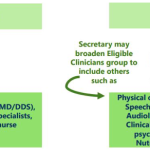 Since April 27 the MACRA Notice of Proposed Rulemaking (NPRM) has been a hot topic. Last week, attendees at a nephrology medical meeting expressed concern about the impact of MACRA on solo and small physician practices. Diana wrote about this concern in the May 23rd blog post that highlighted the now infamous Table 64, which includes CMS data forecasting that 87% of solo practices and 70% of small practices (2-9 eligible clinicians) would face a MIPS penalty in 2019 based on 2017 performance. Are solo and small practices being pushed out? What does MACRA mean for solo and small practices?
Since April 27 the MACRA Notice of Proposed Rulemaking (NPRM) has been a hot topic. Last week, attendees at a nephrology medical meeting expressed concern about the impact of MACRA on solo and small physician practices. Diana wrote about this concern in the May 23rd blog post that highlighted the now infamous Table 64, which includes CMS data forecasting that 87% of solo practices and 70% of small practices (2-9 eligible clinicians) would face a MIPS penalty in 2019 based on 2017 performance. Are solo and small practices being pushed out? What does MACRA mean for solo and small practices?
David Squires and David Blumenthal, former National Coordinator for Health IT and current president of The Commonwealth Fund, recently reported that physician practice size has been changing for a while. Between 1983 and 2014 solo practice declined from 41% to 17% of all U.S. physician practices. Reasons for this change in practice structure include:
- Generational issues, since younger physicians tend to prefer healthcare organizations that support predictable work hours and income
- Local market dynamics, which drive consolidation to manage competition
- Public actions such as MACRA, which place additional administrative burdens on small practices
Despite this trend toward larger practice size, Table 64 in the MACRA NPRM shows that of 761,342 total Eligible Clinicians (ECs) participating in payment year 2014 PQRS, 226,483 or 30% were from solo or small practices.
What is the response to solo/small-practice MACRA concerns?
In May much was written about the plight of solo and small practices with MACRA on the horizon. As a result many people contacted their congressmen to express concern. On May 11 the Ways and Means subcommittee on Health held a hearing on MACRA with Andy Slavitt, Acting Administrator at CMS, as the sole witness. If you have time to spare, you can watch the YouTube video of the 1 hour 30 minute Health subcommittee hearing for some interesting details. The hearing was chaired by Congressman Pat Tiberi from the 12th district of Ohio who set a congenial tone and noted that the purpose of this MACRA meeting was specifically to address the impact on individual and small practice groups.
Congressional members at the subcommittee hearing indicated that there is bipartisan support for MACRA. Both Democrats and Republicans on the subcommittee agree that getting rid of the embarrassment of the SGR was a very good thing and that MACRA embodies the bipartisan goal of controlling healthcare costs while delivering quality. Almost all subcommittee members used their 5 minutes of comments and questions to ask how CMS was going to support solo and small physician groups. Everyone also acknowledged that while physicians have participation in advanced Alternative Payment Models (APMs) as a reporting option, only a small percentage of clinicians will be participating in an eligible APM by 2017. As a result, most of the subcommittee discussion focused on MIPS.
What does the CMS administrator say about MIPS and solo/small practices?
As witness to the Health subcommittee, Mr. Slavitt reported that CMS is striving to be transparent, flexible, and simple in the implementation of MACRA and MIPS. It seems clear that much of the framework presented in the MACRA NPRM will be part of the implementation. Essentially, you may not like the rules, but the rules are clearly laid out so you should begin to move toward participation in MIPS.
CMS feels that MIPS is an improvement for all reporting clinicians. It combines the patchwork of quality reporting programs into a single program with a composite score. Mr. Slavitt noted that the cost of care, which is the “Resource Use” component of the MIPS Composite Performance Score is measured automatically from Medicare claims without any data gathering on the part of the clinician.
Congressman Sam Johnson (TX) specifically asked about MACRA NPRM Table 64 and the impact MIPS penalties might have in “pushing” physicians out of solo and small practices. Mr. Slavitt reiterated that he doesn’t believe Table 64 represents reality since it reflects payment year 2014 when there was a lot of physician PQRS non-participation. It is notable that PQRS participation increased by 47% in payment year 2015.
CMS expressed a desire to make it reasonable for all ECs to participate in MIPS, but there is an emphasis on the bonus and benefits of participating in a Medical Home or qualifying APM programs. Mr. Slavitt noted that CMS will work to qualify existing APMs for MACRA and to actively encourage APM development. In addition, in the future it should be easier for providers to move from one APM to another.
From the comments in the congressional hearing, it appears that CMS is prepared to implement MACRA largely as it is outlined in the NPRM. It is possible that the 90-day quality-measure reporting period— instead of the 365 days for MIPS—may be revisited, but little else seems likely to change substantially. Congress has legislated the program and the proposed CMS implementation plan does not seem to disturb the bipartisan harmony.
Solo/small practice “to do” list
Most clinicians, especially in small practices with Medicare patients should get ready for MIPS reporting. The PQRS-like quality category is worth 50% of the Composite Performance Score. MIPS reduces the reporting burden from 9 to 6 quality measures and there is flexibility to choose the 6 measures that make the most sense for you. Choosing measures is the first step you should be working on now. As Terry noted in the May 30 Acumen blog post, there are no nephrology-specific specialty measures, so nephrology practices will need to choose measures from the general internal medicine pool. For solo and small practices, the 2 required population measures will be automatically calculated by CMS, so there is data-gathering relief for those measures.
Here is the advice from Andy Slavitt to all clinicians:
- Keep focusing on patient care
- Look now at the quality measures and pick the 6 measures that work best for your practice
- If a Medical Home or APM is available to you, explore joining it
- Provide feedback to CMS
CMS wants solo and small practices to remain intact and successfully participate. $20 million per year for the next 5 years is allocated for local aid organizations to support solo and small practices in rural and underserved areas with MACRA training at no cost to the practice.
Of note, at 5 pm today (June 27) the official comment period on the MACRA NPRM closes. After this deadline you may want to contact your congressman especially if she or he is on the Health subcommittee of Ways and Means since this congressional group will have oversight of MACRA implementation.
I’m not sure the solo and small practice folks are feeling the love as much as Mr. Slavitt would like. It is true that solo and small practices have been a hot topic in DC MACRA discussions. Just like Ben Affleck and Jennifer Lopez became Bennifer and Brad Pitt and Angelina Jolie are Brangelina, I think solo and small are headed for So-mall or Small-lo. Just sayin’—they’re all the talk around town.
 Dugan Maddux, MD, FACP, is the Vice President for CKD Initiatives for FMC-NA. Before her foray into the business side of medicine, Dr. Maddux spent 18 years practicing nephrology in Danville, Virginia. During this time, she and her husband, Dr. Frank Maddux, developed a nephrology-focused Electronic Health Record. She and Frank also developed Voice Expeditions, which features the Nephrology Oral History project, a collection of interviews of the early dialysis pioneers.
Dugan Maddux, MD, FACP, is the Vice President for CKD Initiatives for FMC-NA. Before her foray into the business side of medicine, Dr. Maddux spent 18 years practicing nephrology in Danville, Virginia. During this time, she and her husband, Dr. Frank Maddux, developed a nephrology-focused Electronic Health Record. She and Frank also developed Voice Expeditions, which features the Nephrology Oral History project, a collection of interviews of the early dialysis pioneers.




Leave a Reply